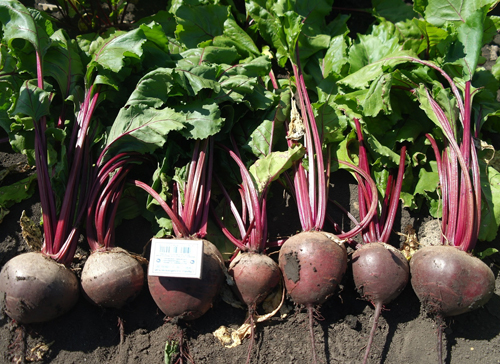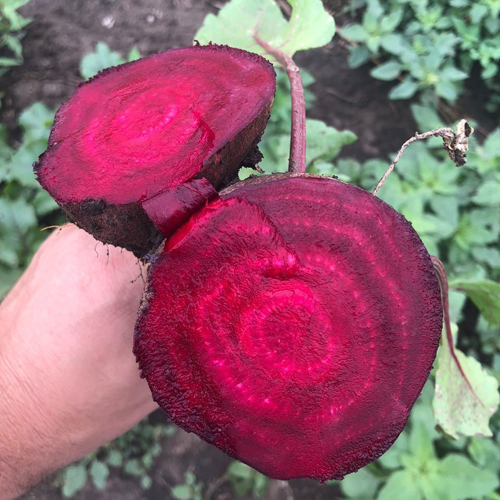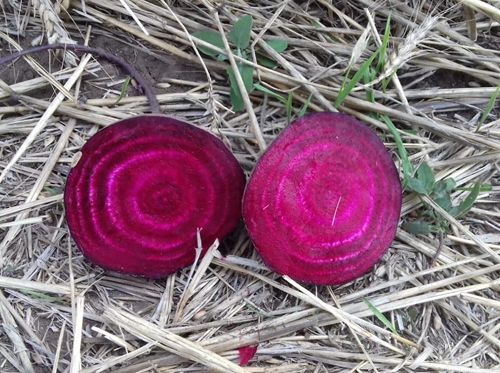Pablo beet variety (F1)
It would seem that it is impossible to surprise a gardener with such a simple vegetable as beets. But the specialists of the Dutch company Bejo managed to do this by developing a new variety called Pablo. This is a hybrid, so when buying seeds, pay attention to the labeling of the bag - it should have the designation F1. Recommended for cultivation in all regions of Russia, as well as in Moldova and Ukraine.

Description
The leaf rosette is upright, powerful. Leaves are medium in size, oval, set on a long petiole. The surface is bubbly, the edge is slightly wavy. The color of the plate is light green with lilac veins. The fruits are not very large, weighing from 108 to 180 g. However, 200-gram root crops can also grow. By all accounts, this variety is an example of the ideal combination of shape and color of the fruit. The shape of the beet is leveled, rounded, 15 cm in diameter. The root tail is thin and long. Pablo's skin is thin and smooth, painted in a dark burgundy color.
The pulp is firm, very tender and juicy, ruby red in color. Ringing is almost completely absent. The taste of the variety is rich, with a predominance of sweetness. 100 grams of the product contains 11.2% solids and 8.8% sugars. Degree Brix, showing the ratio of sucrose dissolved in water to liquid, is 8.6.

Characteristics
- Pablo is a mid-season crop with an average ripening period of 100 days. In the southern regions, harvesting will take place earlier, after 80 days, in cold regions - after 110 - 120;
- beets are very plastic, resistant to unfavorable weather conditions, including cold snaps, therefore they are perfect for regions with cold climates. Ideal for growing in the climatic zone of central Russia;
- originators claim high resistance to shooting and cracking;
- excellent immunity - the variety is practically not exposed to fungal and viral diseases;
- high yield - about 700 c / ha;
- withstands long-distance transportation;

- the shelf life is very long - almost until the new harvest, if all conditions are observed. At the same time, beets do not lose their taste and marketability;
- dining destination. It can be eaten raw, for example, in vitamin salads, it can also be pickled and canned.
Features of agricultural technology
The hybrid is suitable for early cultivation. In the southern regions, seeds are planted in March. In cooler temperatures, the dates are shifted to the first half of May. In order for the crops to begin to sprout, the soil temperature must be about + 6 ° C. You can plant a culture in a seedling way. This method is especially good for high-risk farming regions. For seedlings, planting material is sown about 3 weeks before the intended planting in the ground. Before transplanting, Pablo's seedlings must be hardened.

Choose a sunny place for planting beets, so that the earth warms up well and root crops can accumulate more sugars. From the soil for the variety, loam or sandy loam are suitable, which are very easy to process. On heavy clay soils, the root crop will grow deformed. The rate of seeds per hectare is from 3000 to 6000 pieces.
Care is standard, including timely loosening, weeding, mandatory watering and top dressing. You should not get carried away with nitrogen-containing fertilizers, as they can accumulate in the pulp. The best option is phosphorus-potassium mixtures. For preventive treatments against pests, you can use folk remedies, for example, an infusion of wood ash. It is not worth delaying the cleaning, spend it on time, otherwise the taste and keeping quality may decrease.
To summarize, it's safe to say that Pablo is an amazing beet.Resistance to adverse conditions, excellent yield, transportability and keeping quality make it promising for use on an industrial scale. Unpretentiousness and ease of care made it look popular among gardeners. Excellent taste, which is many times more remarkable than other early species, suitability for all types of processing won the love of housewives.








